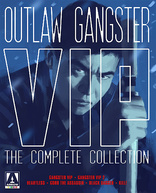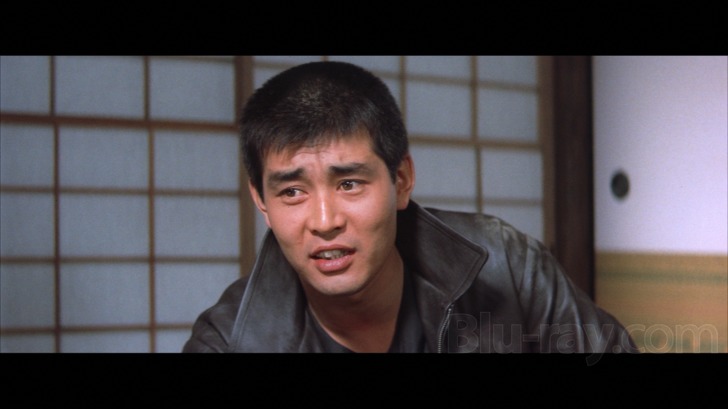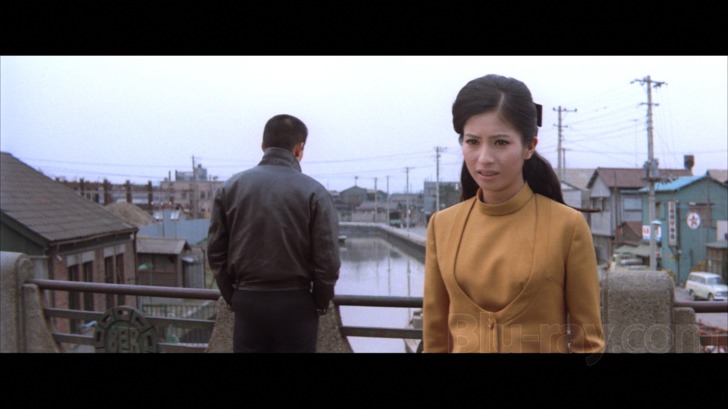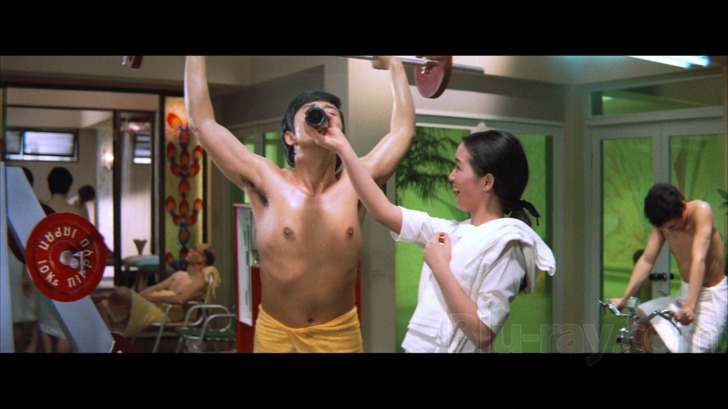Kill! Blu-ray Movie
HomeKill! Blu-ray Movie 
Blu-ray + DVDArrow | 1969 | 86 min | Not rated | No Release Date

Price
Movie rating
7.1 | / 10 |
Blu-ray rating
| Users | 0.0 | |
| Reviewer | 3.0 | |
| Overall | 3.0 |
Overview
Kill! (1969)
Although Goro is a known assassin, he has always been against the ways of the yakuza. In "Outlaw Kill!" he deals with the dilemma of living such a lifestyle more than ever: the sacrifices, the time wasted in prison.
Starring: Tetsuya Watari, Chieko Matsubara, Kôji Wada, Fujio Suga, Eiji GôDirector: Keiichi Ozawa
| Foreign | Uncertain |
| Crime | Uncertain |
| Action | Uncertain |
Specifications
Video
Video codec: MPEG-4 AVC
Video resolution: 1080p
Aspect ratio: 2.45:1
Original aspect ratio: 2.35:1
Audio
Japanese: LPCM Mono
Subtitles
English
Discs
50GB Blu-ray Disc
Two-disc set (1 BD, 1 DVD)
DVD copy
Playback
Region A (B, C untested)
Review
Rating summary
| Movie | 3.0 | |
| Video | 3.5 | |
| Audio | 3.5 | |
| Extras | 1.0 | |
| Overall | 3.0 |
Kill! Blu-ray Movie Review
Reviewed by Jeffrey Kauffman April 24, 2016Note: This film is currently available as part of the Outlaw: Gangster VIP Collection.
It’s certainly not a scientific survey by any stretch of the imagination, but when I quizzed a coterie of Japanese film fan friends of mine to
name a
Japanese film studio, absolutely no one came up with Nikkatsu. Toho was quite popular, as was Toie, but Japan’s oldest studio didn’t even
rate one single, solitary mention. Nikkatsu’s rather redolent history goes all the way back to 1912, easily eclipsing Toho’s genesis circa 1932
or Toie’s origination a few years later in 1938. For whatever reason, though, Nikkatsu, despite its status as the “dean” of Japanese movie
studios, doesn’t seem to have the same general notoriety that some of its competitors do. Nikkatsu may be best remembered by at least
some fans for its so-called “pink film” era, a kind of quasi-soft porn (sometimes maybe a little “harder” than merely soft) approach that
helped the studio weather the roiling 1970s era, when big studios, no matter where they might be located, were facing a rapidly changing
set of demographics and an often frustrating and potentially life threatening new set of economic challenges. One of Nikkatsu’s pre-pink era
calling cards was a short-lived but temporarily almost insanely popular franchise which began with 1968’s Gangster VIP, which is also
known by the slightly different title Outlaw: Gangster VIP. As Jasper Sharp mentions on his commentary for the first film of this new
six film set, the kind of ironic thing about this series coming out of Nikkatsu is that Toie had already staked a claim of sorts on the Japanese
gangster film idiom, kind of like Warner Brothers did in the United States back in the 1930s. The Outlaw: Gangster VIP series wasn’t
very long lived, lasting only around two years from 1968-1969, but it’s a really interesting aggregation of films that should appeal to lovers of
yakuza fare or even those who simply like to ferret out largely unseen entries that have been hidden in the various nooks and crannies of
Japanese cultdom for decades.

Little more than a year after Gangster VIP evidently fanned the flames of a rather short lived rage, the franchise’s final film, Kill! , arrived in 1969 to put the final nail in Goro’s coffin. Right — like that would ever happen. This is probably the least effective of the six films, merely ticking off by now well established plot points without much finesse, but still managing to stage some fun action sequences. In this case, it’s a climactic showdown at a discotheque with a glass floor (evidently so customers can go down below and stare up the skirts of the pretty dancers and singers). Here, as a J-Pop princess warbles a tune, a huge melée unfolds below her (she is of course unaware), with splatters of blood bursting up and dripping off the glass separating the two levels. It’s weird, a little wacky, and one of the better fight scenes in the entire Gangster VIP series.
Once again Goro Fujikawa (Tetsuya Watari) wanders into town and seemingly directly into various intramural conflicts between various yakuza entities. He comes to the aid of pretty elevator girl Yumi (Chieko Matsubara), who is being harassed by a bunch of yakuza toughs. (And, yes, as Kevin Gilvear cheekily points out in the generalist featurette covering all six films, they’d pretty much resorted to simply changing one letter of Matsubara’s characters’ names by this point.) Yumi gets Goro and the nasty thugs to the top of the building, where Goro proves he’s no one to challenge to a duel. It shouldn’t come as any huge surprise that Yumi ends up having a connection to a friend of Goro’s.
There’s little of the engaging social commentary that informed at least some of the previous Gangster VIP outings, and as a result, Kill! pretty much simply lives up to the minimalist ambitions of its title, positing Goro as the lone vigilante out to restore order and justice to a chaotic world. It’s a bit of a letdown for the franchise as a whole, but the film still delivers some decent character beats, especially for Watari who really furrows his brow throughout this one.
Note: Our scoring system can be a little frustrating at times, especially when dealing with a franchise like this. I've rated this final film at 3.0, but I would score this one toward the 2.75 side if I were able to.
Kill! Blu-ray Movie, Video Quality 

Kill! is presented on Blu-ray courtesy of Arrow Films with an AVC encoded 1080p transfer in 2.45:1. All six films in the
Outlaw
Gangster VIP franchise share some common characteristics, and so I will be offering some general assessments that pertain to the series
as a whole before moving on to more specific comments about this particular film. Arrow's brief comments on the provenance of the elements
utilized for these transfers mentions only that "The Outlaw Gangster VIP series was transferred from original preservation film
elements
by Nikkatsu Studios in Japan. All six films were delivered to Arrow Films as remastered files." This unfortunately doesn't really provide a lot of
information, and it's my assumption that at least some of these may have been transferred from secondary sources like prints rather than IPs
or
negatives. Several of the films have recurrent brightness and contrast fluctuations which are quite noticeable and create a kind of slow motion
quasi-flicker, with clear gradations in tones especially visible in darker moments. While elements show various signs of wear and tear, and
feature slight fading which tends to skew flesh tones toward the brown side of things, palettes are overall quite convincing and robust,
especially
when it comes to aspects like the bright red blood that flows so ubiquitously in each of the entries.
Kill! is overall one of the better looking films in the set, one generally unencumbered by the recurrent brightness and contrast
fluctuations that are in evidence in some other entries in the set. While perhaps still a bit over bright, the palette pops quite well, and more
consistent contrast offers at least decent black levels for elements like Goro's leather jacket. The red bathed discotheque scene is evocative
looking, though the lighting scheme understandably depletes detail levels. While still relatively soft looking a lot of the time (something shared
by most of the films in this set), some of the outdoor photography is quite effective and provides decent depth of field. As should be expected,
detail levels are best in close-ups, something this film exploits regularly, where gruesome details like slashes to flesh are offered in all their
"glory". I've rated this a 3.5 to indicate it's better looking than some of the films I graded at 3.0, but I'd probably give this a 3.25 if I were able
to, since detail levels never really rise to staggering levels.
Kill! Blu-ray Movie, Audio Quality 

All six films in this set feature uncompressed LPCM Mono tracks in the original Japanese. None of the films is going to set audiophiles' hearts on fire, but with occasional exceptions (Black Dagger being the most noticeable one), there are few real problems with distortion or other age related issues. The films' dialogue and effects are typically rendered with decent force and fidelity, and the fun scores also sound decent, if narrow. Black Dagger receives the lowest audio score of any film in this set due to some distortion that's evident, most noticeably when music is playing.
Kill! Blu-ray Movie, Special Features and Extras 

- Trailer (1080p; 2:15)
- Gallery (1080p)
Kill! Blu-ray Movie, Overall Score and Recommendation 

Goro may not exactly go out with a whimper, but he doesn't exactly go out with a bang, either, if I may be permitted to bring a probably confused T.S. Eliot into this tale of a chivalric yakuza. Kill! doesn't have much on its mind and tends to just repeat tropes already seen in previous films, but its climactic scene in a discotheque is a lot of fun and one of the highlights of the entire series. Technical merits are among the strongest of the set.
Similar titles
Similar titles you might also like
(Still not reliable for this title)

Black Dagger
1968

Gangster VIP
1968

Gangster VIP 2
1968

Goro the Assassin
1968

Heartless
1968

Massacre Gun
Minagoroshi no kenjû
1967

Hiroshima Death Match
Battles Without Honor and Humanity - Deadly Fight in Hiroshima
1973

The Violent Professionals
Milano trema: la polizia vuole giustizia
1973

Stray Cat Rock: Delinquent Girl Boss
1970

Dead or Alive 2
2000

Battles Without Honor and Humanity
1973

Proxy War
Battles Without Honor and Humanity
1973

Street Mobster
現代やくざ 人斬り与太 / Gendai yakuza: hito-kiri yota
1972

Eight Hours of Terror
8時間の恐怖 / Hachijikan no kyôfu
1957

Doberman Cop
ドーベルマン刑事 / Doberuman deka
1977

Detective Bureau 2-3: Go to Hell, Bastards!
探偵事務所23 くたばれ悪党ども / Kutabare akutô-domo - Tantei jimusho 23
1963

Graveyard of Honor
Jingi no hakaba
1975

New Battles Without Honor and Humanity: The Boss' Head
新仁義なき戦い 組長の首 / Shin jingi naki tatakai: Kumicho no kubi
1975

New Battles Without Honor and Humanity: Last Days of the Boss
新仁義なき戦い 組長最後の日 / Shin jingi naki tatakai: Kumicho saigo no hi
1976

New Battles Without Honor and Humanity
新仁義なき戦い / Shin jingi naki tatakai
1974